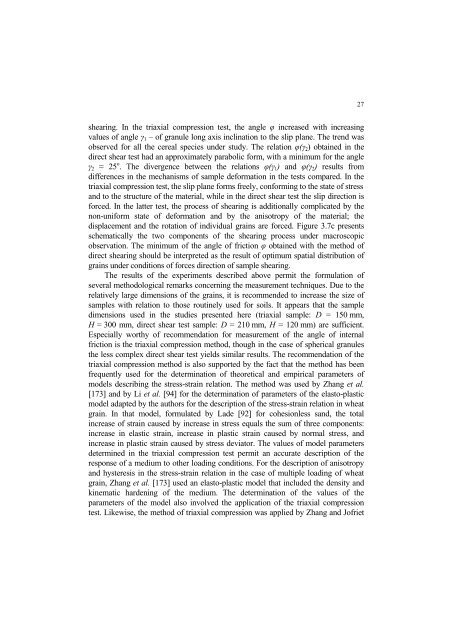Strona 2_redak - Instytut Agrofizyki im. Bohdana DobrzaÅskiego ...
Strona 2_redak - Instytut Agrofizyki im. Bohdana DobrzaÅskiego ...
Strona 2_redak - Instytut Agrofizyki im. Bohdana DobrzaÅskiego ...
You also want an ePaper? Increase the reach of your titles
YUMPU automatically turns print PDFs into web optimized ePapers that Google loves.
shearing. In the triaxial compression test, the angle φ increased with increasing<br />
values of angle γ 1 – of granule long axis inclination to the slip plane. The trend was<br />
observed for all the cereal species under study. The relation φ(γ 2 ) obtained in the<br />
direct shear test had an approx<strong>im</strong>ately parabolic form, with a min<strong>im</strong>um for the angle<br />
γ 2 ≈ 25 o . The divergence between the relations φ(γ 1 ) and φ(γ 2 ) results from<br />
differences in the mechanisms of sample deformation in the tests compared. In the<br />
triaxial compression test, the slip plane forms freely, conforming to the state of stress<br />
and to the structure of the material, while in the direct shear test the slip direction is<br />
forced. In the latter test, the process of shearing is additionally complicated by the<br />
non-uniform state of deformation and by the anisotropy of the material; the<br />
displacement and the rotation of individual grains are forced. Figure 3.7c presents<br />
schematically the two components of the shearing process under macroscopic<br />
observation. The min<strong>im</strong>um of the angle of friction φ obtained with the method of<br />
direct shearing should be interpreted as the result of opt<strong>im</strong>um spatial distribution of<br />
grains under conditions of forces direction of sample shearing.<br />
The results of the exper<strong>im</strong>ents described above permit the formulation of<br />
several methodological remarks concerning the measurement techniques. Due to the<br />
relatively large d<strong>im</strong>ensions of the grains, it is recommended to increase the size of<br />
samples with relation to those routinely used for soils. It appears that the sample<br />
d<strong>im</strong>ensions used in the studies presented here (triaxial sample: D = 150 mm,<br />
H = 300 mm, direct shear test sample: D = 210 mm, H = 120 mm) are sufficient.<br />
Especially worthy of recommendation for measurement of the angle of internal<br />
friction is the triaxial compression method, though in the case of spherical granules<br />
the less complex direct shear test yields s<strong>im</strong>ilar results. The recommendation of the<br />
triaxial compression method is also supported by the fact that the method has been<br />
frequently used for the determination of theoretical and empirical parameters of<br />
models describing the stress-strain relation. The method was used by Zhang et al.<br />
[173] and by Li et al. [94] for the determination of parameters of the elasto-plastic<br />
model adapted by the authors for the description of the stress-strain relation in wheat<br />
grain. In that model, formulated by Lade [92] for cohesionless sand, the total<br />
increase of strain caused by increase in stress equals the sum of three components:<br />
increase in elastic strain, increase in plastic strain caused by normal stress, and<br />
increase in plastic strain caused by stress deviator. The values of model parameters<br />
determined in the triaxial compression test permit an accurate description of the<br />
response of a medium to other loading conditions. For the description of anisotropy<br />
and hysteresis in the stress-strain relation in the case of multiple loading of wheat<br />
grain, Zhang et al. [173] used an elasto-plastic model that included the density and<br />
kinematic hardening of the medium. The determination of the values of the<br />
parameters of the model also involved the application of the triaxial compression<br />
test. Likewise, the method of triaxial compression was applied by Zhang and Jofriet<br />
27
















